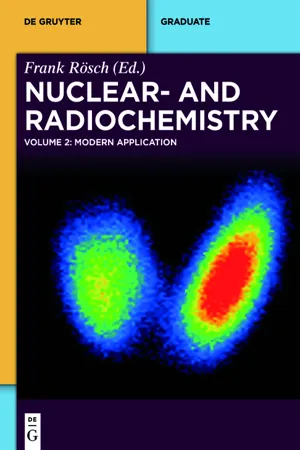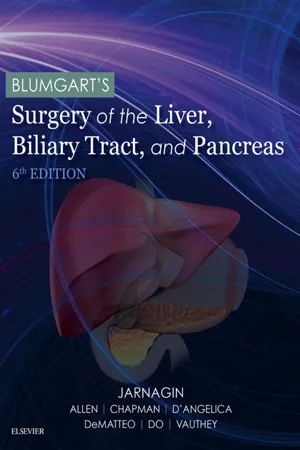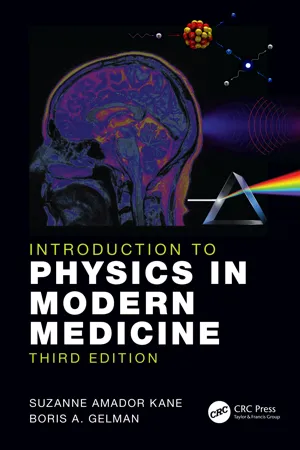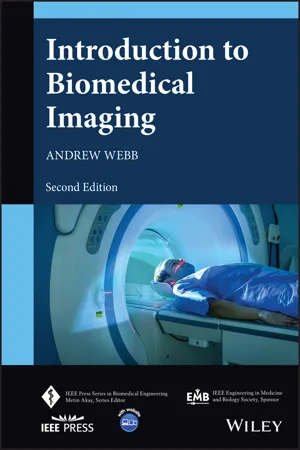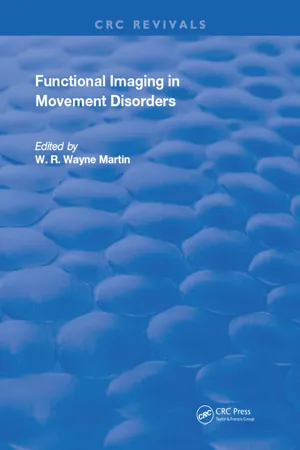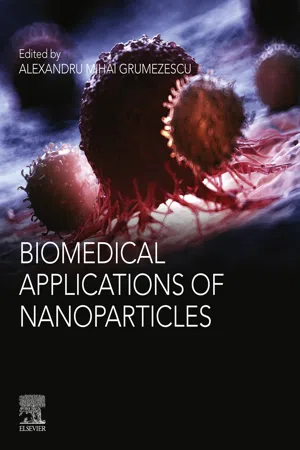Physics
Medical Tracers
Medical tracers are substances used in medical imaging to track the distribution and behavior of specific molecules within the body. These tracers are often labeled with a radioactive or fluorescent tag, allowing them to be detected and visualized using imaging techniques such as PET scans or fluorescent microscopy. Medical tracers play a crucial role in diagnosing and monitoring various medical conditions.
Written by Perlego with AI-assistance
Related key terms
Related key terms
1 of 4
Related key terms
1 of 3
8 Key excerpts on "Medical Tracers"
- eBook - ePub
- Frank Rösch(Author)
- 2016(Publication Date)
- De Gruyter(Publisher)
Tobias L. Ross and Frank Roesch12Life sciences: Nuclear medicine diagnosis
Aim: Molecular imaging in nuclear medicine uses radionuclides attached to relevant molecules in order to illuminate ongoing biological, biochemical or physiological processes on-line, noninvasively and as quantitatively as possible. In order to register the radiation originating from the radiolabeled molecule (then named “tracer”), electromagnetic emissions are needed – in this case photons. The photons are created either by de-excitation of excited nuclear states as a consequence of a primary transition in terms of emission of a single photon, or following a primary positron emission with subsequent annihilation. This defines the tomographic technology used for imaging, i.e. single photon emission computed tomography (SPECT) or positron emission tomography (PET), respectively.This chapter introduces the concept of a radiotracer. It identifies the photonemitting radionuclides of interest. The great opportunities provided by molecular imaging using radiopharmaceuticals are exemplified for the quantitative measurement of energy consumption in the human body, which is the glucose consumption in terms of g per ml and minute. This is achieved by synthesizing and utilizing an 18 F-labeled glucose analog: 2-deoxy-2-[18 F]fluoroglucose, 2-18 FDG.Next, the different chemical approaches to attach these radionuclides to different biomolecules are introduced for covalent 11 C-, 18 F-, and 123 I-labeling as well as for coordinative chemistry needed for e.g. 99m Tc and 68 Ga, 111 In, etc. radiometal labeling.Finally, the most relevant clinical concepts are highlighted for noninvasive diagnosis in patients.12.1Introduction
Molecular imaging is a general approach contributing to addressing two fundamental question of life: What does a certain molecule “do” in the human body, i.e. what kind of biochemical process is it involved in? This question significantly contributes to the principle understanding of how life “works”. One of the most impressive aspects is to “see” how signal transduction proceeds in the living human brain. Once the role of a certain molecule is understood: Could a radiolabeled version of the molecule be used to report on the current status of a biochemical and physiological process for an individual human? If the current status is affected by a disease, the approach will provide diagnostic information. Finally, this will hopefully have consequences for the treatment of that disease. - No longer available |Learn more
- William R. Jarnagin(Author)
- 2016(Publication Date)
- Elsevier(Publisher)
The trace amount of radioactivity and the trace mass of the administered radiotracer are unable to affect (and therefore unable to interfere with measurements of) the biomolecular system or target being assayed. Following this common convention, in this chapter we use radiotracer to refer to radiopharmaceutical administered specifically as a trace, biologically ineffective amount of radioactivity useful solely for diagnostic imaging. We use therapeutic radiopharmaceutical to refer to administration of a relatively high amount of radioactivity with the intent of inducing therapeutic radiobiologic effects in vivo, as discussed later. The radioactivity emitted by a therapeutic radiopharmaceutical may be useful for diagnostic imaging as well as radiotherapy. The clinical diagnostic imaging of therapeutic radiopharmaceuticals' biodistribution in vivo in patients (e.g., to detect or quantify tumor targeting by the radiopharmaceutical) is known as theranostics. Most radiopharmaceuticals in current clinical practice relevant to HPB diseases are administered intravenously. One notable exception is hepatic arterial infusion of radiotracer. Diagnostic Imaging in Nuclear Medicine The diagnostic images of the patient analyzed by the nuclear medicine specialist are the result of technology, pharmacology, and biology. This section focuses on what the clinical imaging specialist and referring clinician need to know to interpret nuclear scan images properly and to avoid misinterpretations that might negatively impact patient care, as well as diagnostic pitfalls by properly preparing patients. In general, diagnostic nuclear imaging is a noninvasive procedure that uses scanning hardware to examine the distribution of a radiopharmaceutical within the internal environment of the body - eBook - ePub
Neuroimaging in Forensic Psychiatry
From the Clinic to the Courtroom
- Joseph R. Simpson(Author)
- 2012(Publication Date)
- Wiley(Publisher)
Part I Imaging TechniquesPassage contains an image 1 PET and SPECT Susan E. Rushing, Daniel A. Pryma and Daniel D. Langleben University of Pennsylvania School of Medicine, Philadelphia, PA, USA Introduction
Nuclear medicine is a medical imaging subspecialty that uses administered radioactive materials to create images that assist in the diagnosis and treatment of disease. Positron emission tomography (PET) and single photon emission computed tomography (SPECT or SPET) are tomographic nuclear medicine techniques commonly used to diagnose malignant, inflammatory, degenerative and circulatory disorders.Tomography is an imaging approach that involves reconstruction of a dataset into three-dimensional (3D) images. It allows higher contrast and improved visualization of structures that would obscure each other on planar images, such as superimposed lung, heart and thoracic spine on a conventional chest X-ray. Tomography first came into widespread use using X-rays in computed tomography (CT). The principle of tomography is now used in most 3D medical imaging techniques.Both PET and SPECT use cameras to detect photons emitted by the radioactive decay of unstable isotopes, which can be radioactive elements themselves, radioactive isotopes synthesized into molecules of interest or radioactive isotopes attached to molecules, to create functional images. These radioactive materials are called radiotracers because they are able to trace processes of interest without perturbing the processes being followed. PET and SPECT differ in the type of isotopes they require, the way they detect the emitted signals and the way the data are reconstructed into images. SPECT is technically simpler, less expensive and has lower spatial and temporal resolution than PET. A forensic practitioner can encounter PET and SPECT scans introduced as evidence of abnormal brain function at various stages of legal proceedings.A chemical element is defined by two parameters: atomic number and atomic mass. Atomic number is the number of protons present in an element and determines the chemical properties of that element. The number of protons and electrons in a given element are fixed. Atomic mass is the total mass of protons, neutrons and electrons in a single atom of a given element. The atomic mass can change based on the number of neutrons. - eBook - ePub
- Suzanne Amador Kane, Boris A. Gelman(Authors)
- 2020(Publication Date)
- CRC Press(Publisher)
By taking successive images a fixed time apart, changes of the radioactive tracer’s distribution over time also can be measured quantitatively. The time behavior of the tracer molecule in the body can be mathematically modeled, allowing physicians to extract the rate of important physiological processes. For example, scans of the kidneys and urinary tract can determine how effectively radionuclides introduced into the bloodstream are properly filtered out and excreted. The filtration rate of the radioactive tracers gives a measure of kidney function for detecting blockages, monitoring the organs’ general health, or seeing whether transplanted organs are working properly.These procedures can provide a lower-cost alternative to more expensive imaging techniques such as MRI. A large signal for imaging can be achieved with extremely small amounts – typically billionths of a gram – of the radiolabeled tracer. Since these minute amounts correspond to concentrations too small for drug activity, the radiopharmaceuticals do not affect body function, although they still must meet federal standards for drug purity and safety. Chapter 7 addresses in more detail how to determine safe levels for the radiation doses resulting from radionuclide imaging.6.5 Emission Tomography with Radionuclides: SPECT and PETA major drawback of radionuclide imaging with a gamma camera is that it only offers a single projection of the body’s structures, rather than giving a three-dimensional picture. Every point on the gamma camera image corresponds to an entire line within the person being imaged (Figure 6.7a ). Radionuclides at many different depths within the body cause only one detector above to respond. This means that planar gamma camera images contain no depth information, and so cannot resolve overlapping structures. This also means that the shape of a structure can be very unclear in a gamma camera image (Figure 6.7 - eBook - ePub
- James R Hanson(Author)
- 2019(Publication Date)
- Royal Society of Chemistry(Publisher)
CHAPTER 9 Labelling Organic Compounds for Diagnostic Imaging 9.1 INTRODUCTION Drugs containing a radioactive nuclide are often described as radiopharmaceuticals. Their medical applications lie in both diagnosis and therapy. Diagnostic radiopharmaceuticals are molecules that are typically labelled with a positron-emitting isotope for use in positron emission tomography (PET) or a gamma-emitting isotope for use in single photon emission computed tomography (SPECT). Diagnostic radiopharmaceuticals are designed to target particular receptors or organs and to provide a non-invasive method of assessing the function of the target and by using isotopes with a short half-life, with relatively little radiation damage to the subject. Therapeutic radiopharmaceuticals, on the other hand, are designed to deliver a cytotoxic radiation dose to diseased, typically tumour, cells. The best known of these are compounds containing radio-iodine, which are used in the treatment of thyroid disease and which were discussed in the previous chapter. Target specificity is again required to minimize radiation damage to healthy tissue. 9.2 POSITRON EMISSION TOMOGRAPHY The development of PET has had a major impact on the synthesis of labelled compounds, requiring the development of rapid methods for incorporating short-lived isotopes such as carbon-11 and fluorine-18 into compounds. Although carbon-11 was described in the 1930s, its short half-life of 20.4 min imposed constraints on its use as a radio-tracer and it was soon overshadowed by the use of carbon-14. Both carbon-11 and fluorine-18 (half-life 109.7 min) decay by the emission of a positron (a β + particle). The positrons from fluorine-18 have a relatively low energy (0.635 MeV) and are annihilated by collision with an electron close (0.5–2 cm) to their site of emission. The annihilation releases two photons at 180° to each other, which can be detected and their point of origin calculated - eBook - ePub
- Andrew Webb(Author)
- 2022(Publication Date)
- Wiley-IEEE Press(Publisher)
- (ii) Scan time is relatively long, approximately 20–30 min. Patient preparation is also quite long, since there needs to be significant time between radiotracer injection and imaging in order for the radiotracer to accumulate in tissue,
- (iii) Injection of even a small amount of radioactivity is an invasive procedure.
(a) Schematic of a three‐camera SPECT scanner and (b) associated brain scan from an injected 99 Tc‐labeled radiotracer. (c) Schematic of one ring of a PET scanner and (d) PET scan of the brain showing the uptake of injected 18 F‐deoxyglucose.Figure 3.1The two main nuclear medicine techniques are single‐photon emitted computed tomography (SPECT ) and positron emission tomography (PET ). Both of these modalities are integrated with a CT scanner, which provides both an anatomical image overlay and images which can be used to correct for the attenuation of radioactivity within the body, which improves quantitation. Figure 3.1 a shows the basic principles and instrumentation for SPECT/CT. The particular radiotracer accumulates in a specific organ and radioactive decay produces γ‐rays, which are emitted in all directions. A collimator is placed between the patient and the detector, so that only γ‐rays which have a trajectory close to 90° to the detector‐plane are recorded. In each detector (there are usually either two or three), a large scintillation crystal converts the energy of the γ‐rays into light. These light photons are in turn converted into an electrical signal by photomultiplier tube s (PMT s). Newer systems use solid state scintillators for direct conversion of γ‐ray energy into electrical signals. After a sufficient number of γ‐rays have been detected, the detectors are rotated to the next position, and data acquisition continues. After full sampling, iterative reconstruction methods very similar to those described in the previous chapter are used for image reconstruction. Figure 3.1 - eBook - ePub
- W. R. Wayne Martin(Author)
- 2019(Publication Date)
- CRC Press(Publisher)
14 C, tissue sampling or autoradiography in animal models, and PET studies in animals with the positron-emitting radiotracer.Although the short half-life of PET radionuclides limits the radiation exposure to subjects who are scanned, this exposure is not negligible. The radiation dosimetry is an important consideration, given the public’s sensitivity to issues relating to radiation and the fact that subjects who are scanned are either normal volunteers or patients who are studied for research purposes rather than as part of their medical care.39 ,40The potential risks associated with these low levels of radiation are carcinogenesis and genetic effects in future generations.41 Although the risk is very low and the exact magnitude controversial, it is agreed that the least amount of radiotracer necessary to perform an adequate PET study should be administered.Methods have been developed to determine the radiation exposure from radiopharmaceuticals, including PET radiotracers.42 ,43The biodistribution kinetics of the specific radiotracer, i.e., a description of the distribution of the tracer in the body as a function of time following its administration is first determined from measurements made in a small group of human subjects,44 ,45from extrapolation of measurements obtained in animals,46 or from calculations that are based on physiologic models of in vivo tracer behavior. Then, for a given radionuclide, the radiation exposure to each organ in the body is calculated. Limits on radiation exposure to subjects participating in research studies are set by various regulatory bodies, such as the U.S. Food and Drug Administration, and also by institutional human studies committees. Radiation exposures for typical PET studies, as well as for certain diagnostic procedures, are listed in Table 2 - eBook - ePub
- Alexandru Mihai Grumezescu(Author)
- 2019(Publication Date)
- William Andrew(Publisher)
Sundin et al., 2007 ). Molecular imaging quantification is the determination of regional concentrations of molecular imaging agents and biological parameters. Both endogenous molecules and exogenous probes can be molecular imaging agents. Further, molecular imaging quantification provides measurements of processes at molecular and cellular levels. Molecular imaging offers unique insights into the human body that enable physicians to personalize patient care. In terms of diagnosis, molecular imaging is able to- • provide information that is unattainable with other imaging technologies or that would require more invasive procedures such as biopsy or surgery;
- • identify disease in its earliest stages and determine the exact location of a tumor, often before symptoms occur or abnormalities can be detected with other diagnostic tests.
Nuclear medical imaging methods, such as SPECT and PET, utilize radioisotope-labeled biomolecules and provide scanning of gamma rays produced by radioactive decay. While these two methods are not the same, the theoretical principles and the practical imaging procedure are largely preserved with these methods.Positron-emitting radiopharmaceuticals are the principal agents for molecular imaging because in vivo labeled biochemical processes and metabolic pathways (i.e., glycolysis and protein/DNA synthesis) represent key agents for molecular imaging when compared with gamma radiating radiopharmaceuticals that can indirectly engage a specific metabolic function (Lucignani and Bombardieri, 2004 ). However, positron-emitting radio compounds have some disadvantages, because their production depends on the presence of an on-site cyclotron and the final process is expensive (Palumbo et al., 2014 ). Radiolabeled compounds that only have a long half-life do not require cyclotron in on-site, because they can be transported in a different place from where they are synthesized and therefore commercially available. Fluorinated compounds have a longer half-life of 18 F, which is more useful and more common when compared with those labeled by other radioisotopes such as 11 C (20 min), 15 O (about 2 min), or 13 N (about 10 min). In addition, the spatial resolution of the PET scan is up to 5 mm, and the spatial resolution of the SPECT is about 10 mm (Palumbo, 2008 ; Bé et al., 2003
Index pages curate the most relevant extracts from our library of academic textbooks. They’ve been created using an in-house natural language model (NLM), each adding context and meaning to key research topics.
Explore more topic indexes
Explore more topic indexes
1 of 6
Explore more topic indexes
1 of 4
